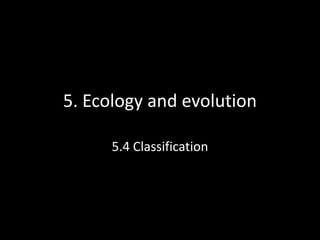
5.4 Classification
- 1. 5. Ecology and evolution 5.4 Classification
- 2. Some vocabulary Phylogeny: the evolutionary history of a group of organisms. Phylogenetic trees: formal hypotheses that identify likely relationships among species. Taxonomy: the identification and naming of species and their placement in a classification. Classification: an arrangement of organisms into hierarchical groups that reflect their relatedness Taxon: The organisms included within any category of the taxonomic hierarchy
- 3. The Binomial System of Nomenclature Carl von Linné (Carolus Linnaeus) invented a system in which species are assigned a two-part name, hence binomial. The first part identifies a group of species with similar morphology: genus The second part is the specific epithet or species Ex.: Ursusmaritimus(polar bear), Pan troglodyte (chimpanzee), Homarusamericanus(lobster).
- 4. Rules for binomial nomenclature the first name is the genus name the genus name is always capitalized the second name is the species name the species name is not capitalized italics are used if the name is printed the name is underlined if handwritten 4
- 5. Taxonomic Hierarchy The taxonomic hierarchy Linnaeus defined is easily applied to Darwins Arranges organisms into ever more inclusive categories or taxa. Largest to smallest: Kingdoms : Prokaryotae, Protoctista, Fungi, Plantae and Animalia. Phylum, Class, Order, Family, Genus, Species 5
- 6. Blue Whale Coast Redwood Taxon Kingdom Phylum Class Order Family Genus Species Animalia Chordata Mammalia Cetacea Balaenopteridae Balaenoptera musculus Plantae Coniferophyta Pinopsida Pinales Taxodiaceae Sequoia sempervirens 6
- 8. Traits of organisms as systematic characteristics Linnaeus focused on external anatomy. Ex.: a bird is a class of oviparous (egg-laying) animals, with feathered bodies, two wings, two feet, and a bony beak. No other animals possess all these characteristics. Two types of characteristics: morphological characters and behavioral characters Molecular differences also help classify different organisms with similar characters
- 9. Examples using simple external recognition features Plant classification: Life cycle of a plant: male and female gametes fuse together zygote develops into an embryo how embryo develops depends on the type of plant it is Four plant phyla: Bryophyta – mosses, livewortsand hornworts Coniferophyta – conifers Filicinophyta – ferns Angiospermophyta – flowering plants
- 10. * Indicates dispersal stage
- 11. Examples using simple external recognition features Animal classification: Life cycle of an animal: gametes fuse zygote develops into an embryo blastula different systems form, such as skeletal, nervous, digestive, blood, etc. Animals are divided into over 30 phyla based on their characteristics Examples of 6 phyla
- 12. Examples from six animal phyla
- 13. Arthropoda With jointed legs & segmented body. Have a hard exoskeleton made up of chitin. True champions of diversity & adaptation as they have conquered most habitat world wide. There are over a million species of arthropods worldwide. Eg.: insects, spiders, scorpions & crustacean like crabs & shrimps. 13
- 14. Time to put you to the test! From the following pictures: Study the organisms and assign each one to its phylum 2. List the organisms that are A) bilaterally symmetric B) radially symmetric C) not symmetrical in their structure 3. List the organisms that have Jointed appendages Stinging tentacles Bristles 4. List the organisms that filter feed by pumping water through tubes inside their bodies.
- 15. Invertebrate diversity Alcyoniumglomeratum Pycnogonumlittorale Adociacinerea Nymphongracilis
- 16. Invertebrate diversity Lepidonotusclava Corynactisviridis Polymastiamammiliaris Cyaneacapillata
- 17. Invertebrate diversity Caprellalinearis Loligoforbesii Procedoreslittoralis Gammaruslocusta Arenicola marina Prostheceraeusvittatus
- 18. Dichotomus key It consists of a numbered series of pairs of descriptions to help assign a species to the correct group. One description should clearly match the species and the other should clearly be wrong. They should be reliable and easily visible. Each description leads either to another numbered pair in the key, or to an identification 18
- 20. Dichotomos keys, homework Apply and design a key for the ten organisms in your handout based on their footprints.
